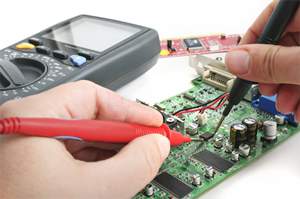
PCB Design for Assembly
 Printed Circuit Board Design for Assembly (DFA) is critical to AV Elecauto who outsource PCBs for design and manufacturing. If correctly performed, it shortens the product cycle, minimizes development cost, and ensures a smooth transition into production from prototype stages. Unfortunately, the AV Elecauto product engineering team often accelerates design and development cycles and fails to place emphasis on high volume production considerations such as fixtures, casting, or extrusions, for example. In cases like these, PCB prototype engineers intend to quickly get the product on a test bench, to do proof of concept validation rather than emphasizing Design for Assembly (DFA) considerations.
Printed Circuit Board Design for Assembly (DFA) is critical to AV Elecauto who outsource PCBs for design and manufacturing. If correctly performed, it shortens the product cycle, minimizes development cost, and ensures a smooth transition into production from prototype stages. Unfortunately, the AV Elecauto product engineering team often accelerates design and development cycles and fails to place emphasis on high volume production considerations such as fixtures, casting, or extrusions, for example. In cases like these, PCB prototype engineers intend to quickly get the product on a test bench, to do proof of concept validation rather than emphasizing Design for Assembly (DFA) considerations.
The prudent approach is to first examine the volume production considerations. The main reason is there are different DFA considerations related to prototype PCB assembly versus production PCB assembly. Each requires a different design skill set and equipment. If the right approach isn't used, costs can escalate, and debugging the product can be costly, as well. At PCB prototype levels, the validity of the circuitry and functionality of the circuit board is far more important than the testability and manufacturing guidelines that are necessary to implement at the PCB production level to make the production smooth and flawless.
 The first article approval of the PCB is the initial most important step toward effective PCB Design for Assembly. An OEM approved first article PCB proves valuable in answering all questions relating to manufacturing, assembly and test. It is the “ proof of concept ” before a PCB order goes into production, even if the quantities are small, like less than 10 to 50. The first article ensures that the transition into production volumes is smooth with few to no questions left unanswered. Plus, for the OEM, smooth transition to production means key market demands such as time-to-market, quality, reliability, product delivery, and the very critical time-to-revenue are met.
The first article approval of the PCB is the initial most important step toward effective PCB Design for Assembly. An OEM approved first article PCB proves valuable in answering all questions relating to manufacturing, assembly and test. It is the “ proof of concept ” before a PCB order goes into production, even if the quantities are small, like less than 10 to 50. The first article ensures that the transition into production volumes is smooth with few to no questions left unanswered. Plus, for the OEM, smooth transition to production means key market demands such as time-to-market, quality, reliability, product delivery, and the very critical time-to-revenue are met.
